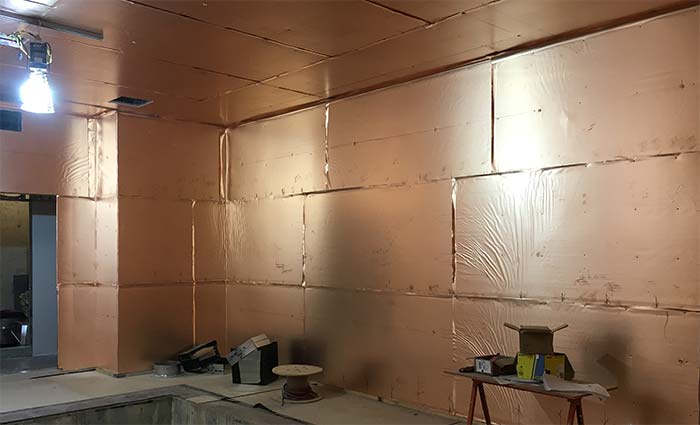Shielding is used in buildings to protect people and equipment from the effects of other nearby items. Shielding is most often used in medical/dental buildings and research laboratories due to the specialty equipment and compounds used in those types of facilities. Architects working in the healthcare and institutional sectors will need to understand the various kinds of shielding available.
Shielding can be used to protect the contents of a room or object (prevent something from getting in) or it can be used to protect everything outside a room (prevent something from getting out). For instance, passersby should be protected from the radioactive materials in a laboratory storage room (prevent something from getting out). Or, a sensitive piece of equipment may want to be protected from radio waves entering the space and affecting test results (prevent something from getting in).
There are two main types of shielding used in medical and research buildings: electromagnetic shielding (including radio frequencies and magnetic fields) and ionizing radiation shielding (including x-rays and radioactive material). Each category requires the use of different materials to prevent harmful exposure.
Electromagnetic Shielding
Electromagnetic shielding in buildings generally protects sensitive devices from external interference. In some cases, it can also be used to keep an object's field contained so that it doesn't interfere with other objects or equipment. Electromagnetic interference (EMI) comes in many forms such as radio frequencies, magnetic fields, and electrical fields. An expert in EMI shielding should design the shielding systems due to the complexity involved.
Shielding from electromagnetic interference is usually accomplished passively by using metal sheets such as copper, aluminum, steel, or metal alloys. Copper is usually used to protect equipment from radio frequency and electrical interference, but aluminum and steel also work. Steel plate or silicon steel are usually used to keep magnetic fields from extending further out into the environment.

There are also active shielding options where a compensation system continuously measures the electromagnetic fields of a space and generates balancing fields that counteract the harmful fields. Due to their cost and need for regular maintenance, active systems are reserved for situations where passive systems prove inadequate.
It is important that all six sides of a room are properly shielded because electromagnetic fields extend in all directions and are not "line-of-sight" like ionizing radiation. It is also critical that all penetrations in the shield are properly protected using filters or waveguides. Filters prevent electrical cables and wires from transmitting EMI into a space. Waveguides prevent air ducts and water pipes from transmitting EMI into a space.
The most challenging EMI to shield against is quasi-static DC field interference. This occurs when large, moving metal objects pass through the earth's magnetic field and generate a ripple of DC fields, which can affect sensitive equipment such as MRI machines or electron microscopes. Such interference can be caused by trucks, cars, or buses passing too close to sensitive equipment. Since vehicles tend to be far enough away to not be a problem, the biggest culprit for quasi-static DC field interference are elevators, which are generally dispersed throughout medical and research facilities. The best way to avoid this problem is to keep elevators far enough away from sensitive equipment. An engineer, physicist, or equipment manufacturer can help determine the separation required.
Ionizing Radiation Shielding
Humans must be protected from ionizing radiation to prevent serious health risks. Radiation in healthcare and research facilities often comes in the form of x-rays or tracer elements used during diagnostic procedures. It is also found during radiation therapies, such as treatments for cancer. Rooms that are used for certain diagnostic imaging procedures or for radioactive treatments are shielded to keep the radiation from escaping and compromising nearby people.
There are three ways of protecting from ionizing radiation:
- Time - allow the radiation to decay
- Distance - keep the radiation away from humans
- Absorption - shield humans with a material that absorbs the radiation
Time and distance are fairly self-explanatory, so we will focus on absorption, also known as shielding.
It is critically important that a physicist design ionizing radiation shielding. Different types of radiation will interact with various shielding in different ways. In fact, it is possible to make radiation more lethal if the wrong type of shielding is used. However, the basic premise is to increase the level of shielding, the mass and thickness of the shielding material should be increased.
The most common way that ionizing radiation is stopped is by providing a lead shield. This is easily seen in a dentist office where a patient wears a lead apron and the technician moves behind a lead-lined wall during an X-Ray. Since X-Rays are fairly low-dose radiation, they can be stopped with a thin lead shield. Higher doses of radiation may require a room to incorporate lead-lined drywall, lead-lined plywood, or lead bricks.
Certain types of radiation require increased protection. In that case, thick concrete walls can be used or the density of the concrete can be increased through the use of more aggregate or different additives. High-density concrete blocks are also available to help absorb ionizing radiation. In some situations, such as around linear accelerators, high-density concrete walls may need to be four feet thick. When this isn't possible, there are other more expensive options.
Where significant neutron shielding is required in thinner and lighter construction, the physicist can design a shield using pure or borated polyethylene. The lightness of the material makes it ideal for shielding doors or other moving objects.
Summary
It is worth noting once again, that shielding for any form of radiation (electromagnetic, ionizing, etc) is highly complex and must be undertaken by an expert in the field. An architect must hire a physicist or other engineer with the expertise to ensure safety. However, it is possible to properly shield facilities to keep specialized machines running smoothly while protecting the health of the people who will be nearby.


